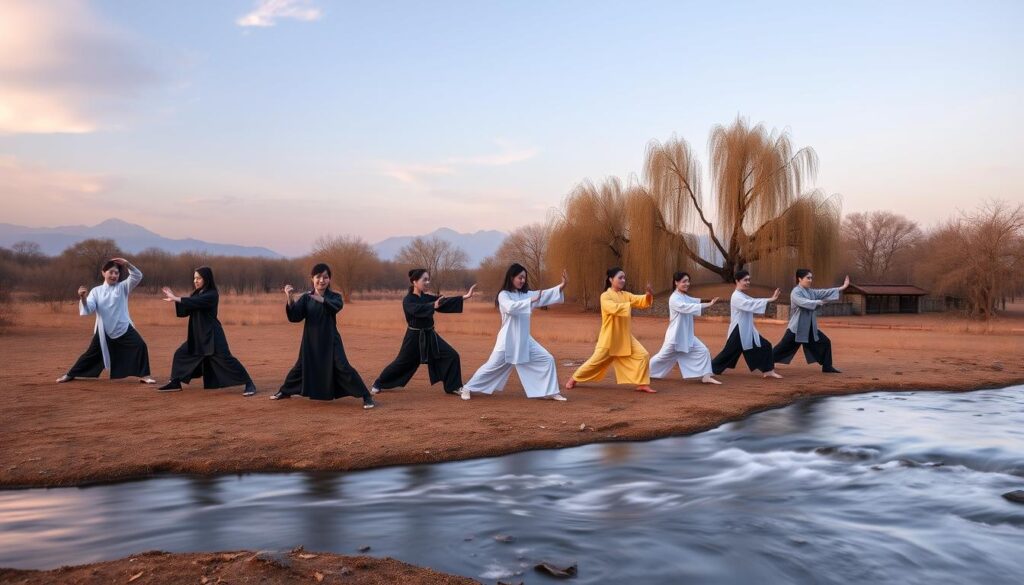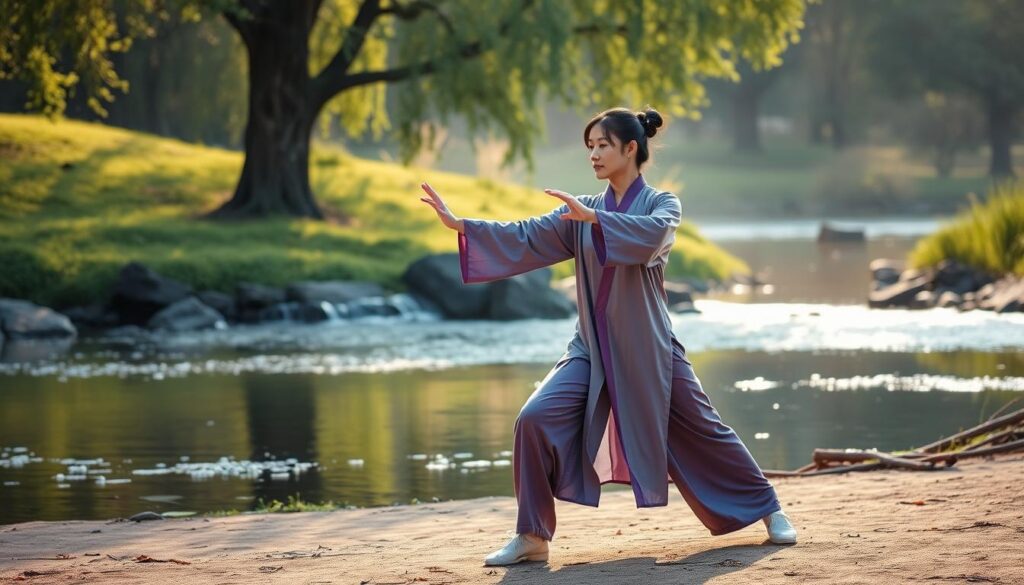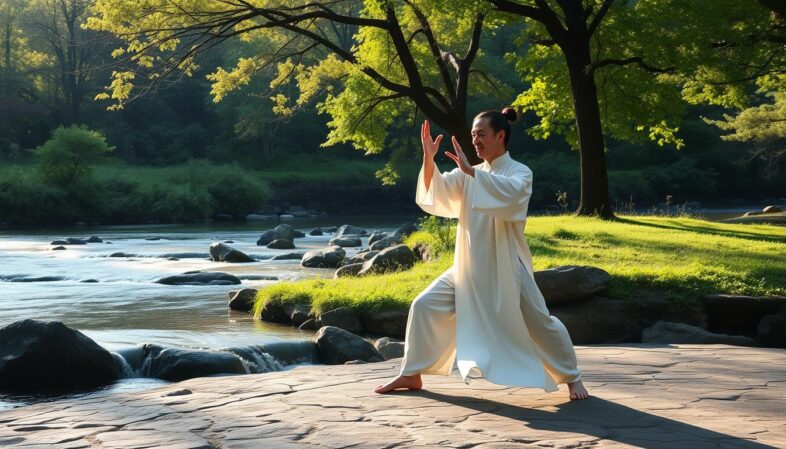Did you know 35% of Tai Chi fans try out more than one style? This fact shows how diverse and appealing Tai Chi forms are, especially Yang style. As someone who loves martial arts and seeks mind-body balance, Yang Tai Chi really stands out. It’s a mix of tradition and something easy to learn.
Yang style was started by Yang Luchan in the mid-1800s. It’s now one of the most loved Tai Chi styles around the world. Its focus on smooth, flowing movements makes it different from other martial arts. It offers a special way to improve both body and mind.
The Yang style’s 24-form sequence is a favorite for beginners. It doesn’t need any special gear and can be done every day for the best results. This makes it easy for many people to try and enjoy Tai Chi. It’s becoming more known as both a martial art and a way to meditate.
In this article, we’ll look into Yang Tai Chi’s history, main ideas, and different forms. We’ll also talk about its health benefits and how it compares to other Tai Chi styles. Whether you’re already into it or just starting, you’ll learn a lot about this ancient practice of balancing mind and body.
Key Takeaways
- Yang style is the most widely practiced Tai Chi form globally
- The 24-form Yang Tai Chi sequence is ideal for beginners
- Daily practice is recommended for optimal benefits
- Yang Tai Chi requires no special equipment
- It offers both physical and mental health benefits
- Yang style emphasizes gentle, flowing movements
- It’s considered both a martial art and a form of meditation
Table of Contents
- 1 Introduction to Yang Tai Chi Forms
- 2 The Essence of Yang Tai Chi Forms
- 3 Popular Yang Tai Chi Forms
- 4 Detailed Breakdown of Yang Tai Chi 24 Form
- 5 Learning Yang Tai Chi 8 Form for Beginners
- 6 Advanced Yang Tai Chi Forms
- 7 Incorporating Yang Tai Chi Forms into Daily Practice
- 8 The Health Benefits of Practicing Yang Tai Chi Forms
- 9 Yang Tai Chi Forms for Specific Populations
- 10 Comparing Yang Tai Chi Forms to Other Tai Chi Styles
- 11 Tools and Resources for Learning Yang Tai Chi Forms
Introduction to Yang Tai Chi Forms

Yang Tai Chi forms are an important part of Tai Chi history. Yang Luchan, the founder, made Chen-style Tai Chi easier to learn. He created various Yang Tai Chi forms for different skill levels and goals.
Yang-style Tai Chi: A Brief History
The Yang family lineage started with Yang Luchan in the 19th century. He brought Tai Chi to Beijing, where it became popular among the elite. Yang’s teachings evolved into a gentler, flowing style that focused on health and martial arts.
The Importance of Forms in Tai Chi Practice
Tai Chi forms are the core of practice. They teach proper technique, body alignment, and energy flow. Through form practice, practitioners improve balance, flexibility, and mental focus.
The repetitive nature of forms helps deepen Tai Chi principles.
Different Yang Tai Chi Forms
Yang-style Tai Chi offers various forms for different needs:
- Long Form (108 movements): The traditional, comprehensive form
- Simplified 24-Form: A shorter version for beginners
- 8-Form: A concise practice for those with limited time
- 10-Form: Slightly more complex than the 8-Form
- 40-Form: A balanced option between the Long Form and shorter versions
Each form captures the essence of Yang-style Tai Chi. They promote health, balance, and inner strength. The variety of Yang Tai Chi forms ensures that all practitioners can find a suitable practice to improve their well-being.
The Essence of Yang Tai Chi Forms

Yang-style Tai Chi was founded by Yang Luchan in the mid-19th century. It’s the most popular Tai Chi style worldwide. Its gentle, flowing movements make it easy for people of all ages and fitness levels to practice.
Key Principles of Yang-style Tai Chi
Yang Tai Chi focuses on smooth motions and Qi circulation. The style emphasizes:
- Simplifying complex movements
- Maintaining a stable center
- Applying softness against hardness
These principles help practitioners improve balance and mental focus.
Benefits of Practicing Yang Tai Chi Forms
Yang Tai Chi offers physical and mental benefits. Regular practice can improve:
- Flexibility and balance
- Cardiovascular health
- Reduced stress and anxiety
- Better sleep quality
Studies show Tai Chi reduces stress and lowers blood pressure.
Yang Tai Chi Forms vs Other Styles
Yang style is known for its gentle, flowing movements. It’s different from Chen style’s explosive power. Yang style focuses on continuous motion and cultivating internal energy. This makes it great for health-focused practitioners.
| Style | Characteristics | Focus |
|---|---|---|
| Yang | Gentle, flowing movements | Health benefits |
| Chen | Explosive power, spiraling movements | Martial applications |
| Wu | Compact movements, emphasis on balance | Internal energy cultivation |
Yang Tai Chi forms range from 16 to 108 movements. The 108-move form takes 3-4 years to master. Shorter sets like the 24-move form are quicker to learn for beginners.
Popular Yang Tai Chi Forms

Yang Tai Chi forms offer a wide range of practices for all levels. They vary in complexity and length, meeting different needs and skill levels.
Yang-style Long Form (108 movements)
The Yang-style Long Form has 108 movements. It’s a detailed practice that explores Yang Tai Chi deeply. It requires focus and smooth movement throughout its long sequence.
Simplified 24-Form Yang Tai Chi
The 24-Form Tai Chi is great for beginners. It was made by the Chinese Sports Commission. It keeps the essence of Yang style but is shorter, perfect for those with less time or space.
Yang-style 8-Form Tai Chi
The 8-Form Tai Chi is perfect for beginners. It teaches the basic Yang Tai Chi principles. It’s a short form that introduces important movements and concepts.
Yang-style 10-Form Tai Chi
The 10-Form Tai Chi is a step up from the 8-Form. It adds a bit more complexity. It’s great for those who want to learn more without diving into longer forms.
| Form | Movements | Difficulty | Time to Learn |
|---|---|---|---|
| Long Form | 108 | Advanced | 6-12 months |
| 24-Form | 24 | Intermediate | 2-4 months |
| 8-Form | 8 | Beginner | 2-4 weeks |
| 10-Form | 10 | Beginner-Intermediate | 3-6 weeks |
Detailed Breakdown of Yang Tai Chi 24 Form

The Yang Tai Chi 24 Form is the most popular Tai Chi worldwide. It was created in 1956 by the Chinese Sports Committee. This version is easy for beginners but still keeps the essence of Tai Chi.
Origins and Development
Four Tai Chi masters worked together to make the 24-Form Tai Chi. They simplified the traditional 108-move Yang style into a 24-move routine. This takes about six minutes to do. It’s designed to quickly teach Tai Chi’s basics to new learners.
List of 24 Movements
The 24-Form Tai Chi includes critical Yang style postures. Each movement flows smoothly into the next. This makes it easier to learn and practice, focusing on left-right balance.
| Movement Number | Posture Name |
|---|---|
| 1 | Opening Form |
| 2 | Part Wild Horse’s Mane |
| 3 | White Crane Spreads Wings |
| 4 | Brush Knee and Push |
| 5 | Hand Strums the Lute |
Key Postures and Their Significance
Each posture in the 24-Form Tai Chi is important. “Grasp the Bird’s Tail” helps with balance, and “Single Whip” improves energy flow. These postures mix martial arts with health benefits, enhancing overall well-being.
Tips for Mastering Each Movement
Mastering Tai Chi takes patience and practice. Focus on proper body alignment and smooth transitions. Regular practice builds muscle memory and improves performance. Always breathe naturally and stay relaxed during the routine.
Learning Yang Tai Chi 8 Form for Beginners

The Yang Tai Chi 8 Form is great for beginners. It’s a shorter version that still captures the essence of Yang style. I’ll show you the basics and share tips for mastering it.
Overview of the 8 Form Sequence
The Tai Chi 8 Form is a simplified version of the Yang Style 60 movements. It focuses on seven critical postures from the original form. This makes it perfect for Yang Tai Chi beginners. It was created for students to practice at home and learn basic Tai Chi principles.
Step-by-Step Guide to Each Movement
When practicing the 8 Form sequence, move slowly and deliberately. Focus on your breath and body awareness. Here’s a brief overview of the movements:
- Opening posture
- Grasp Bird’s Tail
- Single Whip
- Lift Hands
- White Crane Spreads Wings
- Brush Knee and Push
- Cloud Hands
- Closing posture
Common Mistakes and How to Avoid Them
Beginners often rush through movements or distribute their weight incorrectly. Take your time with each posture and pay attention to your balance. Remember, Tai Chi is about flowing movements, not quick actions.
Progressing from 8 Form to More Complex Forms
As you master the 8 Form sequence, you can progress to more complex forms. The Standard Simplified 24 Taijiquan Form is a natural next step in your Tai Chi progression. This form, developed in 1956, is suitable for students of all ages and serves as a foundation for Yang Style Tai Chi.
With consistent practice, you’ll build the skills needed to tackle more advanced forms like the Traditional Yang Style Long Form, which consists of 108 postures. Remember, Tai Chi is a journey – enjoy each step along the way.
Advanced Yang Tai Chi Forms

Yang Tai Chi has forms ranging from simple to complex. The Yang-style Long Form, with 108 movements, is the top Advanced Tai Chi form. It requires stamina, focus, and a deep grasp of Tai Chi principles.
Yang-style Long Form (108 movements)
The Yang Long Form, with 108 movements, is the full expression of Yang Tai Chi. It tests practitioners’ focus and energy over its long sequence. It’s a deep dive into energy flow and martial arts.
History and Significance
Yang Luchan created the Long Form, later refined by his descendants. It’s an important form in Tai Chi, seen as the ultimate test of skill and endurance. Its complexity allows for a deep exploration of Tai Chi principles.
Sequence Overview
The Yang Long Form includes a variety of movements. It starts with gentle warm-ups, then moves to complex sequences, and ends with cooling down exercises. Each movement flows smoothly into the next, creating a dance-like routine.
Mastering the Long Form: Challenges and Benefits
Mastering the Long Form is challenging. It demands a lot of time, physical endurance, and mental focus. But the rewards are great. Practitioners see improved balance, flexibility, and strength. They also gain insights into Tai Chi philosophy and energy manipulation.
| Aspect | Challenge | Benefit |
|---|---|---|
| Time | Requires long practice sessions | Develops patience and discipline |
| Physical | Demands stamina and flexibility | Improves overall fitness and balance |
| Mental | Requires intense focus and memory | Enhances cognitive function and mindfulness |
| Spiritual | Calls for deep understanding of Tai Chi principles | Promotes inner peace and energy awareness |
Incorporating Yang Tai Chi Forms into Daily Practice

Yang Tai Chi forms offer a wide range of practices for daily routines. The traditional Yang style has forms with 88 to 120 movements. Modern adaptations, like the Beijing form, have just 24 movements. This variety makes it easy to Tai Chi fitness adaptation for any schedule or ability.
Creating a Practice Routine
To start a Daily Tai Chi practice, begin with shorter forms. Then, move to longer sequences as you get better. It’s important to be consistent and focus on proper body movement, not just repeating actions.
Balancing Form Practice
A good Tai Chi routine includes different parts:
- Form practice
- Foundational exercises (Jibengong)
- Single movement practice
- Partner work and push hands (in later stages)
This mix helps build a strong Tai Chi body method (shenfa) and improves your skills.
Adapting for Different Fitness Levels
The 26-section foundation routine shows how Tai Chi can be adapted. It keeps the core Yang Style principles but allows for changes:
- Suitable for compact spaces
- Adaptable for various skill levels
- Structured progression from simple to complex movements
This makes it simpler to keep up with a Tai Chi routine, no matter your fitness level or busy schedule.
The main goal of your Tai Chi routine is to improve body awareness, precision, and movement freedom. By focusing on these, you’ll understand Tai Chi better and get more from your practice.
The Health Benefits of Practicing Yang Tai Chi Forms

Yang Tai Chi forms bring many health benefits. This ancient practice has caught the eye of researchers globally. Over 500 trials and 120 systematic reviews have been published in the last 45 years.
Physical Benefits
Yang style research shows it’s great for preventing falls in older adults and improving balance. It also boosts strength in lower limbs and increases aerobic capacity. Yang Tai Chi forms help those with osteoarthritis, Parkinson’s disease, and COPD.
Mental and Emotional Benefits
Mental health and Tai Chi are closely connected. Studies show it improves depression and cognitive functioning. Practitioners often see reduced anxiety, better focus, and improved sleep.
Research Findings
Yang style research shows benefits for many health conditions:
- Cardiac and stroke rehabilitation
- Dementia management
- Enhanced quality of life for cancer patients
- Fibromyalgia relief
- Hypertension control
Importantly, no studies found Yang Tai Chi forms to worsen any health condition. This low-impact exercise is considered safe. Only minor musculoskeletal adverse events have been reported.
Yang Tai Chi Forms for Specific Populations

Yang Tai Chi forms are great for different groups. They help with fall prevention and improve athletic performance. These practices are adaptable to various needs.
Seniors and Fall Prevention
Tai Chi is becoming popular for seniors as a safe exercise. The Yang-style Tai Chi helps improve balance and strength. This reduces the risk of falls.
Seniors often start with the 24-Form, which is quick to learn. It takes about 5 minutes to complete.
Athletes and Performance Enhancement
Athletes use Yang Tai Chi to improve their performance. It enhances body awareness and mental focus. Many athletes add the Yang 10 Form to their training.
This short sequence includes important movements. These are “parting wild horse’s mane” and “single whip.”
Stress Relief for Busy Professionals
Yang Tai Chi forms help busy professionals manage stress. The 42 Forms, introduced in 1989, are a complete practice in 6 minutes. This makes it easy to fit into a busy schedule.
| Population | Recommended Form | Key Benefit |
|---|---|---|
| Seniors | 24-Form Yang Tai Chi | Fall prevention |
| Athletes | 10-Form Yang Tai Chi | Body awareness |
| Professionals | 42-Form Tai Chi | Stress relief |
Yang Tai Chi forms meet various needs, from preventing falls to managing stress. Their flexibility makes them suitable for all ages and fitness levels.
Comparing Yang Tai Chi Forms to Other Tai Chi Styles

Tai Chi styles have their own special traits. I’ve tried many and seen big differences in how they move and what they focus on. Each style offers its own set of benefits.
Chen-style Tai Chi Forms
Chen style is the oldest Tai Chi form. It’s known for its powerful movements and low stances. It has three main ways to practice, based on how you bend your legs.
Young people might like the lower forms. But older folks find the higher forms better for them.
Wu-style Tai Chi Forms
Wu style is all about stretching your body. You lean forward and backward a lot. Its movements are smaller and more precise than Yang style.
Sun-style Tai Chi Forms
Sun style mixes Tai Chi with other martial arts. It’s all about quick, smooth hand movements. This style combines Tai Chi with Bagua and Hsing-I.
| Style | Key Characteristics | Suitable For |
|---|---|---|
| Chen | Explosive movements, lower stances | All ages, martial artists |
| Wu | Body extension, compact movements | Those seeking balance improvement |
| Sun | Agility, flowing circular movements | Practitioners interested in multiple martial arts |
| Yang | Gentle, flowing movements | Beginners, seniors |
Every Tai Chi style has its own benefits. Chen style strengthens your legs, Wu style improves balance, Sun style boosts agility, and Yang style increases flexibility. The right style depends on what you want to achieve and your physical condition.
Tools and Resources for Learning Yang Tai Chi Forms
I’ve found many Tai Chi learning resources to help you master Yang Tai Chi forms. These tools fit different learning styles and skill levels. They make it easy for anyone to start or improve their practice.
Recommended Books and Videos
Tai Chi books offer deep knowledge and guidance. “The Harvard Medical School Guide to Tai Chi” by Peter Wayne and Mark Fuerst is a top choice. It mixes scientific research with practical tips, great for those looking for solid information.
For those who learn better by watching, instructional videos are perfect. They show Yang Tai Chi forms step by step. This lets you follow along at your own speed.
Online Courses and Virtual Classes
Online Tai Chi classes are getting more popular. They offer flexibility and convenience. These courses break down the 24 Forms Taijiquan, with 24 movements from earlier standards.
Virtual classes give real-time feedback from experienced teachers. This helps you avoid mistakes and improve your technique. Many online platforms also teach Qigong exercises, which complement Tai Chi practice.
With these resources, you can build a solid learning experience. Regular practice with these tools can greatly improve your balance, flexibility, and overall health. Yang style Tai Chi is perfect for beginners and those looking to reduce stress and relax.
